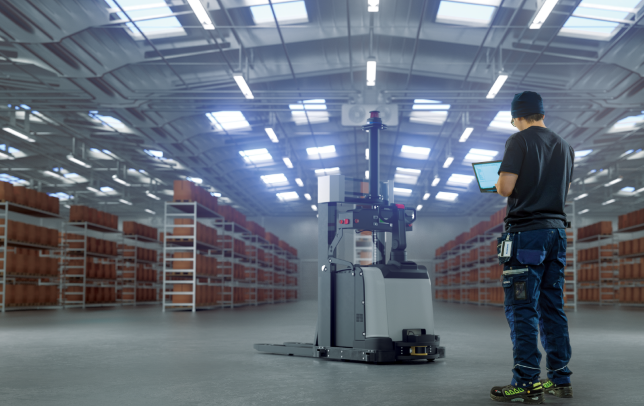AGV performance: a deep-dive into neural networks
27th October 2021

Machine Learning, Neural Networks – big terms in modern logistics, but what do they actually mean? What we need is an expert to tell us. Paul Hamblin, editor of Logistics Business magazine, meets one.
AGV and mobile robotics specialist Kollmorgen measures the performance and behaviour of AGV systems, both on a system level and on board individual AGVs. It collects information on motor drives, laser scanners, localisation, traffic, and obstacle interference, thus finding trends and patterns which help it to improve products and system configurations.
Highs and lows in productivity or daily utilisation trends might be measured, and the data used to optimise routes, increase throughput and calculate smarter resource utilisation. To the end-user, this translates into lower costs and higher revenue. The collected data can also give important clues to external processes that might disturb AGV performance. For example, pedestrians getting in the way of the AGVs, or manual forklifts driving in areas originally planned primarily for the AGVs.
How does it do all this, though? Samuel Alexandersson, Manager Product Management AGVs at Kollmorgen is our patient guide.
“An artificial neural network is a computational model that is loosely based on the structure of the human brain,” he begins. “Our brain cells, or neurons, are connected by an intricate network of nerves along which electrochemical signals travel. Simplified, we can say that if the weighted of input signals are strong enough, the neuron will fire, and the signal will continue on to the next set of cells the neuron is connected to.
“In this manner, the structure of the connections between all the different neurons in our brain will determine how a signal is propagated, and when we learn new things, what is really happening inside our brain, is that the connections are restructured.
“In an artificial neural network, the signals are digital instead of electrochemical, and the strengths of the connections are stored in weights. Initially, these weights will have random value, meaning when we feed an input to the network, it will just output random nonsense. But in the same way we humans learn from experience, we can let the model learn from experience in the form of data.
“Each datapoint will be an input and an expected output, so these pairs are examples to learn from. Using these so called Machine Learning algorithms to gradually adjust the weights, will bring the output from the model closer and closer to the expected output, so that it can learn to make predictions.
“For example, if we are to teach a machine to see the difference between a cat and a dog, we need to construct a dataset with images (inputs), where each image has a label indicating if it is a cat or a dog (the correct outputs). After training the neural network on the dataset, we may feed it with a new image, and even though this image has never been seen by the network before, it will tell us if it is a cat or a dog.”
Can he offer examples of how insights can be generated from data in a logistics context?
“Designing an AGV system can be a complex task that requires a lot of skill and experience,” he replies. “When designing the road network for example, there can be tens of thousands of individual road stretches that need to be configured correctly. Of course, it is easy to make a mistake and often such mistakes are not discovered until you run the system in a simulation.
“Therefore, we are currently developing tools that can analyze the road network directly, so that the user gets more immediate feedback. In internal AB-tests, we saw a 5x improvement in time it took users to find the root cause in a faulty configuration.
“A more anecdotal indication of the impact we can have with a data-driven approach, is a support case where something that an engineer had been debugging for several hours with conventional methods were resolved within 10 minutes using a prototype that automatically analyses the configuration data.”
So there we have it – as always, it’s all about cats and dogs.

